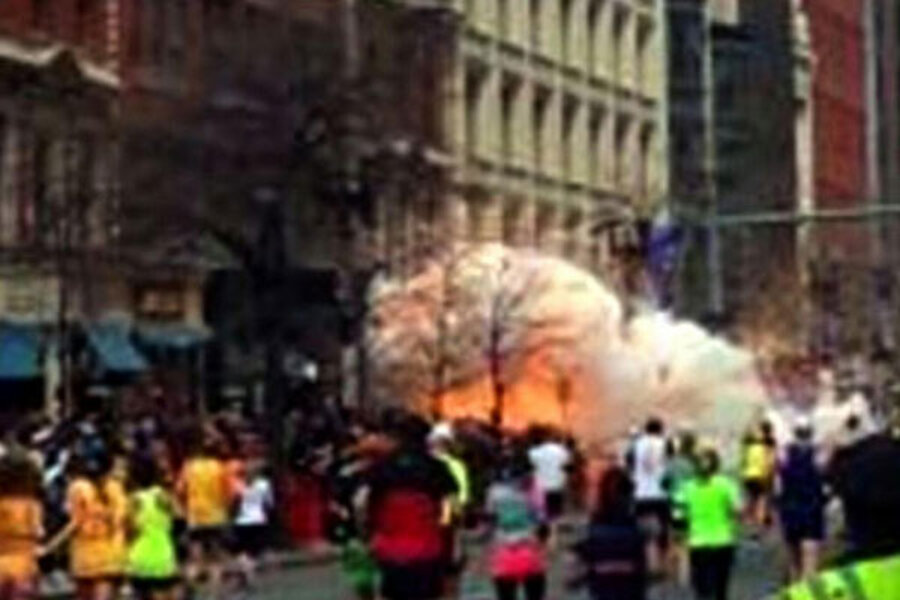In Boston Marathon bombings, spectators' pictures could hold crucial clues
Loading...
| Boston
Law enforcement officials said the investigation of the Boston Marathon bombings will seek to take full advantage of the fact that hundreds of spectators were shooting photos and videos around the time of the twin blasts.
The crime scene – right near the finish line – was one of the world’s busiest photography scenes. Not only were marathon fans snapping photos and videos, but surveillance cameras in nearby stores and cameras filming the race for TV networks were positioned near the finish line.
“We would like to review any kind of media that you have out there,” said Richard DesLauriers, the FBI special agent leading a multiagency investigation into Monday's attack.
The quest for digital media is just one piece of an investigation that also includes interviewing witnesses and analyzing the explosives. But it could be an important piece, given the sheer quantity of images from the scene.
Several speakers at a Tuesday morning briefing by officials in Boston emphasized the call for spectators to come forward with images, even if those images may seem insignificant or were taken well before the explosions that occurred at 2:50 p.m. along Boylston Street in Boston’s Back Bay neighborhood.
“Tell us what time those photos were taken,” added Boston Police Commissioner Edward Davis, seeking to simplify the work of investigators sifting through the images. He said images taken close to the explosions, in time and space, would probably have greater value than those further removed from it.
The morning briefing provided few hints of where the investigation may be heading.
Mr. DesLauriers of the FBI said his team received numerous tips to pursue, but cautioned that the investigation would take time. The several-block crime scene alone “is going to take several days to process.”
Federal and local officials called for patience and cooperation from the public. And they voiced determination in pursuing justice after an act that killed three spectators and left 176 people injured, according to a tally Tuesday morning.
“This will be a worldwide investigation,” DesLauriers said. “We will go to the ends of the earth to identify the subject or subjects [responsible] and to bring them to justice.”
Suffolk County District Attorney Daniel Conley described the bombing as an “act of cowardice” that “cannot be justified or explained. It can only be answered.”
Elected leaders, from President Obama to Boston Mayor Thomas Menino, also emphasized the goodness that has emerged in the wake of Monday’s attack, as people in Boston and beyond responded with courage and love.
“What the world saw yesterday … were stories of heroism and kindness,” Mr. Obama said, citing examples of people who ran toward the bomb victims to help save lives, or who took distraught spectators into their homes.
The investigation, by the FBI and other federal agencies on the Joint Terrorism Task Force, so far has no one in custody.
Officials said that, contrary to some news reports Monday, only two known explosives had been discovered – the two that detonated seconds apart along the race course. No other bombs had been found in subsequent searching.
Commissioner Davis said there would be an expanded Boston Police presence for some time, but not because of any known threat to the public.
“We want you to live your life,” he told Boston residents. He encouraged them to “come and go” as usual, except for a 12-block crime scene that will shrink in coming days.
Of 176 people who were admitted to local hospitals because of explosion-related injuries, Davis said 17 were in “critical” condition.
The head of trauma care at Massachusetts General Hospital, George Velmahos, described the patients there as “stabilized” and expressed hope that all will survive.
Doctors said the bomb wounds included shrapnel from metal fragments apparently included in the bombs – pellets or nail-like objects that, in their number and consistency, differed from random objects propelled by the explosion, such as metal from a garbage can.
The Associated Press, citing an unidentified person briefed on the investigation, is reporting that the bombs were pressure cookers filled with metal. Explosive devices made using pressure cookers have been used in acts of terrorism in other countries, including Afghanistan.
Boston Police say that anyone with information, tips, or photos should dial 800-CALLFBI.








